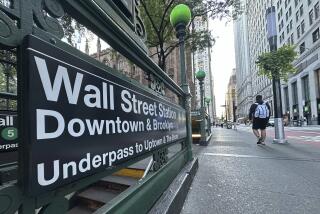Stock market indexes jump more than 4% in 3rd quarter
- Share via
NEW YORK — Investors plowed $900 billion into the stock market in the third quarter, sending major indexes more than 4% higher after bold moves by central banks to shore up the European and U.S. economies.
The Dow Jones industrial average ended the third quarter up 4.3% to 13,437.13, the Standard & Poor’s 500 index rose 5.8% to 1,440.67, and the technology-heavy Nasdaq composite soared 6.2% to 3,116.23. The rally has now seen blue chip stocks rise 11 times during the past 12 months.
Driving the market has been growth in sectors such as energy, telecommunications and consumer services. It helped put the S&P; 500, considered Wall Street’s broadest indicator, only 6% away from where it was five years ago before the Great Recession.
“We’ve made back what we had,” said Howard Silverblatt, senior index analyst at S&P; Dow Jones Indices. Although, he added, “It was a roller coaster ride.”
Wall Street’s rally may hit some rocks in the year’s remaining three months, however, as investors brace for a Washington showdown over the “fiscal cliff” that, if unresolved, threatens to push the fragile U.S. economy back into recession.
Investors may also get jittery as public companies report earnings in coming weeks. Third-quarter corporate profits for companies in the S&P; 500 index are expected to drop 2% compared with the year-ago period, though analysts disagree over the extent to which stock prices already reflect downbeat forecasts.
And investors may not get much more help from central banks, which rode to the rescue during the third quarter.
The European Central Bank embarked on an unlimited bond-buying program to ease debt burdens of struggling countries such as Greece, Italy and Spain. Analysts see the move as taking a near-term collapse of the Eurozone off the table
In the U.S., the Federal Reserve launched an open-ended third round of monetary stimulus known as quantitative easing. By buying bonds and reducing yields, the Fed hopes to spur investment by lowering borrowing costs and luring money into riskier assets like stocks.
“The markets have already rallied in response to the announcements by the ECB and the Fed, and to get significant further upside you will probably need to see somewhat better news on growth, because that picture has not brightened, and in fact over the last few months, it’s worsened a bit,” said Larry Kantor, managing director and head of research at Barclays.
Despite the Fed’s efforts to steer investors into riskier assets like corporate bonds, mortgage-backed securities and stocks, U.S. government bonds still carry yields near historic lows. The yield on the benchmark 10-year Treasury bond hovered around 1.6% Friday.
This has been fueled in part by investor demand for safe investments, as countries in Europe face higher risks of defaults, according to Brian Brennan, a bond portfolio manager for T. Rowe Price in Baltimore.
“It’s still just the risk-free asset globally that continues to be in demand,” Brennan said of Treasury bonds, adding: “Investors have gotten used to low yields.”
No one on Wall Street seems to expect Congress and President Obama to resolve the so-called fiscal cliff before the Nov. 6 election. Many expect more partisan brinksmanship before the automatic tax hikes and spending cuts that are due to kick in at the end of the year.
As each side digs in, Wall Street could get nervous.
“It’s likely to be messy,” said Kantor, and “could produce a lot of angst in the market.”
Recent economic data for the U.S. economy have painted a mixed picture. The housing market has shown continued signs of recovery, but factory orders and other measures of demand have been sluggish.
The next most important piece of economic data comes Friday when the U.S. Department of Labor releases September’s unemployment report. Payroll growth was disappointing in the third quarter, particularly in June and August, when the economy added only 45,000 and 96,000 jobs, respectively.
For the meantime, however, the Fed’s pledge to pump in more money as needed has calmed investor jitters.
“The fear in the market has subsided a bit — not completely, it’s still there,” said Tim Murphy of the TIM Group, which tracks institutional brokerages’ trading strategies. “We’ve seen some improvement in confidence and sentiment, but not back to normal levels yet.”
More to Read
Inside the business of entertainment
The Wide Shot brings you news, analysis and insights on everything from streaming wars to production — and what it all means for the future.
You may occasionally receive promotional content from the Los Angeles Times.










